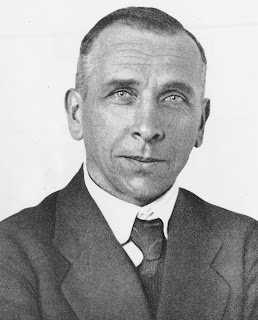Search This Blog
Welcome to Wikigamma – Your Ultimate Destination for Personal Biographies, Achievements & Life Stories
Featured
- Get link
- X
- Other Apps
Alfred Wegener: The Man Behind the Theory of Continental Drift
Alfred Wegener was a German scientist, geophysicist, and meteorologist best known for his groundbreaking theory of continental drift. Although his ideas were not fully accepted during his lifetime, they later became the foundation for modern plate tectonics, one of the most important theories in Earth science. Wegener's life story is one of curiosity, determination, and a deep love for nature and science.
Early Life and Education
Alfred Wegener was born on November 1, 1880, in Berlin, Germany. He was the youngest of five children in a well-educated family. His father was a pastor and teacher who encouraged his children to pursue knowledge. From a young age, Wegener showed a strong interest in nature, science, and exploration.
Wegener studied physics, meteorology, and astronomy at the University of Berlin, the University of Heidelberg, and the University of Innsbruck. He earned his Ph.D. in astronomy in 1905. However, his passion for Earth sciences led him to focus on meteorology and geophysics.
Career and Scientific Work
Wegener started his career at the Aeronautisches Observatorium (Aeronautical Observatory) in Lindenberg, near Berlin. There, he worked with weather balloons to study the upper atmosphere. In 1906, he joined an expedition to Greenland, where he collected weather data under extreme Arctic conditions. This experience would greatly influence his later work.
He later became a professor of meteorology and geophysics at the University of Marburg. Wegener was known for his creative thinking and willingness to challenge established scientific beliefs.
The Birth of the Continental Drift Theory
In 1910, Wegener noticed something interesting: the coastlines of continents like South America and Africa seemed to fit together like puzzle pieces. This observation led him to think that the continents were once connected.
In 1912, Wegener presented his theory of continental drift. He suggested that all continents were once part of a single supercontinent called "Pangaea," which means "all lands" in Greek. According to him, Pangaea began to break apart millions of years ago, and the pieces slowly drifted to their current positions.
Evidence for Continental Drift
Wegener supported his theory with several types of evidence:
-
Geological Evidence: Similar rock formations and mountain ranges were found on continents that are now far apart, such as the Appalachian Mountains in North America and the Caledonian Mountains in Europe.
-
Fossil Evidence: Identical fossils of ancient plants and animals were discovered on different continents. For example, fossils of the extinct reptile Mesosaurus were found in both South America and Africa.
-
Climate Evidence: Wegener found signs of past climates that did not match current locations. For example, evidence of glaciation (ice coverage) was found in present-day tropical regions, suggesting that these areas were once closer to the poles.
-
Fit of the Continents: The shape of the continents, especially the eastern coastline of South America and the western coastline of Africa, appeared to fit together almost perfectly.
Opposition and Criticism
Despite the strong evidence, Wegener's theory faced heavy criticism. Most scientists of his time did not believe that continents could move. One major problem was that Wegener could not explain how the continents drifted. He suggested that the continents plowed through the ocean floor, but this idea was not scientifically convincing.
Geologists argued that there was no known force strong enough to move entire continents. As a result, his theory was largely rejected by the scientific community during his lifetime.
Return to Greenland and Tragic End
Wegener remained passionate about his research and continued to explore Greenland. In 1930, he led another expedition to study the polar atmosphere and ice sheets. Sadly, during this expedition, Wegener disappeared in a snowstorm and was later found dead. He died on November 1930, at the age of 50.
His body was buried in the ice, and the exact location of his grave remains unknown to this day. His sacrifice and dedication to science left a lasting legacy.
Rediscovery and Acceptance of His Theory
Although Wegener's theory was dismissed for many years, new discoveries in the mid-20th century revived interest in continental drift. In the 1950s and 1960s, scientists found evidence of seafloor spreading and plate tectonics. These discoveries confirmed that the Earth's crust is made up of plates that move slowly over time.
With this new understanding, Wegener's ideas gained widespread acceptance. Today, the theory of plate tectonics, which includes the concept of continental drift, is a fundamental part of Earth science.
Legacy and Impact
Alfred Wegener is now recognized as one of the pioneers of modern geology. His theory changed the way we understand Earth's structure and its dynamic nature. Wegener showed that challenging established ideas can lead to great discoveries, even if recognition comes later.
His work laid the foundation for the study of earthquakes, volcanoes, mountain formation, and the movement of continents. He also contributed to meteorology and polar research.
Conclusion
Alfred Wegener's life and work remind us that scientific progress often requires bold thinking and the courage to go against popular opinion. Although he did not live to see his theory accepted, his contributions to science continue to shape our understanding of the Earth.
From a curious young boy in Berlin to a daring explorer in Greenland, Wegener's journey was filled with passion and determination. His legacy lives on in the theory of continental drift and the modern science of plate tectonics.
- Get link
- X
- Other Apps



Comments
Post a Comment